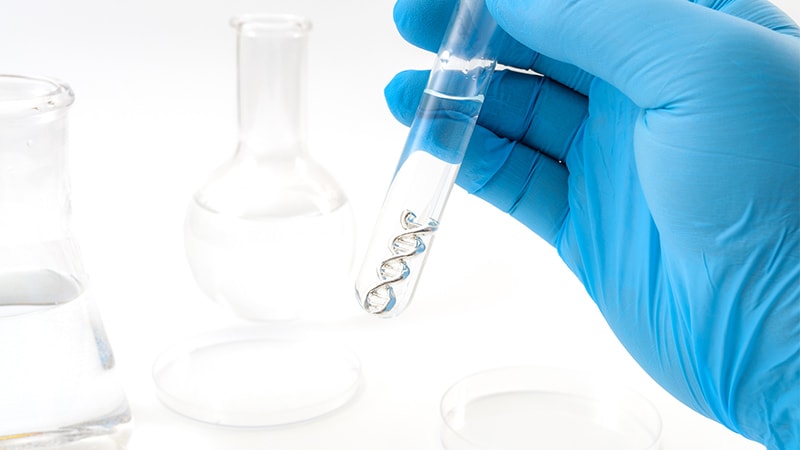
Giving patients and their providers genetic test results for kidney failure risk promotes positive behavioral change that could decrease an individual's likelihood of developing chronic kidney disease (CKD) and end-stage renal failure (ESRF), a new pilot study suggests.
"Disclosing APOL1 (apolipoprotein L1) genetic testing results to patients of African ancestry with hypertension and their clinicians was associated with a greater reduction in systolic blood pressure (SBP), increased kidney disease screening, and positive self-reported behavior change in those with high-risk genotypes," Girish Nadkarni, MD, MPH, Icahn Mount Sinai School of Medicine, New York City, and colleagues report.
"These two measurements — the change in blood pressure and increased kidney function tests — act as hallmarks for detecting beneficial lifestyle change," Nadkarni noted in a statement from his institution.
"For many years, researchers have wondered whether reporting APOL1 genetic test results would help improve clinical management. This is the first pragmatic randomized clinical trial to test this out [and] these results suggest we are headed in the right direction," he added.
The study was published online March 4 in JAMA Network Open.
A Quarter of Those With High-Risk Genotype Changed Medication Behavior
High-risk APOL1 genotypes confer a 5- to 10-fold increased risk for CKD and ESRF caused by hypertension and are found in one out of seven individuals of African ancestry. People of African ancestry also have the highest age-adjusted prevalence of high blood pressure and the lowest rates of blood pressure control, Nadkarni and colleagues explain in their article.
They studied a total of 2050 patients of African ancestry with hypertension but without CKD who were randomized to undergo either immediate APOL1 testing (intervention group) or delayed APOL1 testing (control group).
"Patients randomly assigned to the intervention group received APOL1 genetic testing results from trained staff [while] their clinicians received results through clinical decision support in electronic health records," the investigators explain.
Control patients received results after 12 months of follow-up. The mean age of the cohort was 53 years and almost two thirds were female. Mean baseline SBP was significantly higher in patients with high-risk APOL1 genotypes, at 137 mmHg, compared to those with low-risk APOL1 genotypes, at 134 mmHg (P = .003), and controls, at 133 mmHg (P = .001), the authors report.
At 3 months, "all groups had some decrease in SBP," Nadkarni and colleagues observe.
However, patients with high-risk APOL1 genotypes had a significantly greater decrease in SBP, at 6 mmHg, compared with a mean decrease of 3 mmHg for those with low-risk APOL1 genotypes (P = .004) as well as controls (P = .01). At 12 months, there was no significant difference in SBP or change in SPB from baseline to 12 months between the three groups.
"All three groups showed a significant increase in the rate of urine protein testing over time," the authors add.
Again, however, the most significant increase in urine protein testing over time was seen in patients with high-risk APOL1 genotypes, with a 12% increase from baseline compared with a 6% increase for patients with low-risk APOL1 genotypes and a 7% increase among controls. The difference was significant only between patients with high-risk APOL1 genotypes and controls (P = .01).
Significantly more patients with high-risk APOL1 genotypes, at 59%, reported making positive lifestyle changes as reflected in better dietary and exercise habits after receiving their test results than did those with low-risk APOL1 genotypes, at 37% (P < .001).
Moreover, 24% of those with high-risk genotypes reported that receiving test results changed how they take their blood pressure medication compared with only 10% of those with low-risk genotypes.
More high-risk genotype carriers also reported taking their medications more often, at 10%, compared with 5% of low-risk genotype carriers (P = .005).
On the other hand, more patients with the high-risk genotype, at 27%, worried that they would develop kidney problems than low-risk carriers, at 17% (P < .001). Although investigators did offer patients the opportunity to speak with a genetic counselor at no cost, none chose to do so, the authors note.
Small Improvements
As the investigators emphasize, the magnitude of blood pressure improvement seen in high-risk APOL1 carriers was small.
However, they did not provide specific blood pressure target recommendations or blood pressure-lowering strategies, which, had they done so, may have brought blood pressure down to a greater degree, they hypothesize.
Health behavior changes were similarly small and may not have been clinically that meaningful.
Still, "Results suggest that the trial clearly influenced those who received positive results and may have had some positive effects on other patients," Nadkarni concluded.
Nadkarni is a cofounder of and has equity in Renalytx, and has been a member of the scientific advisory board and received personal fees from the company. He is also a cofounder of Pensieve Health.
JAMA Netw Open. 2022;5:e221048. Full text
Follow Medscape on Facebook, Twitter, Instagram, and YouTube.
"behavior" - Google News
March 09, 2022 at 09:57PM
https://ift.tt/ygZHi6W
Community Genetic Testing Prompts Behavior Change in Patients - Medscape
"behavior" - Google News
https://ift.tt/B0hukHW
Bagikan Berita Ini














0 Response to "Community Genetic Testing Prompts Behavior Change in Patients - Medscape"
Post a Comment